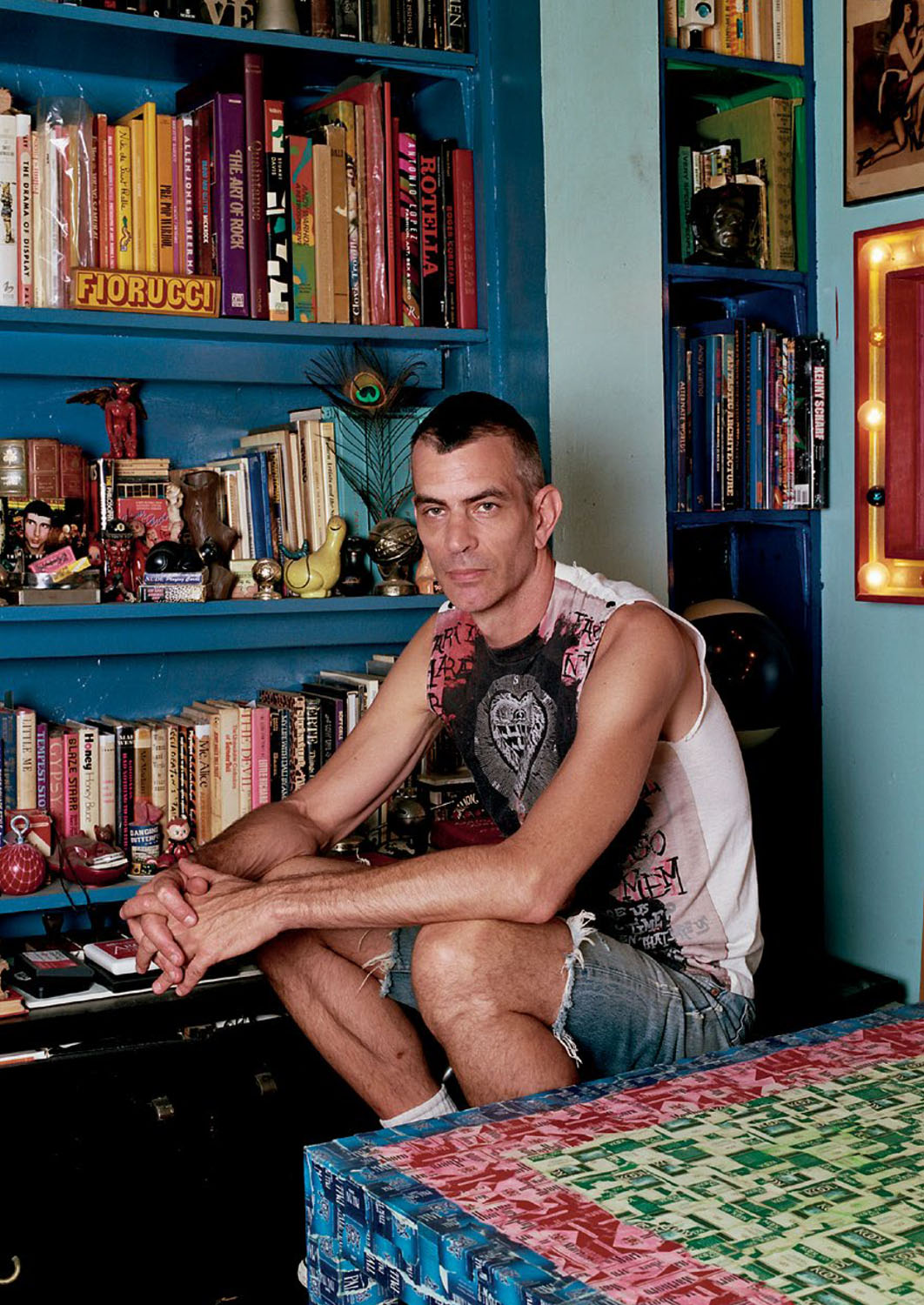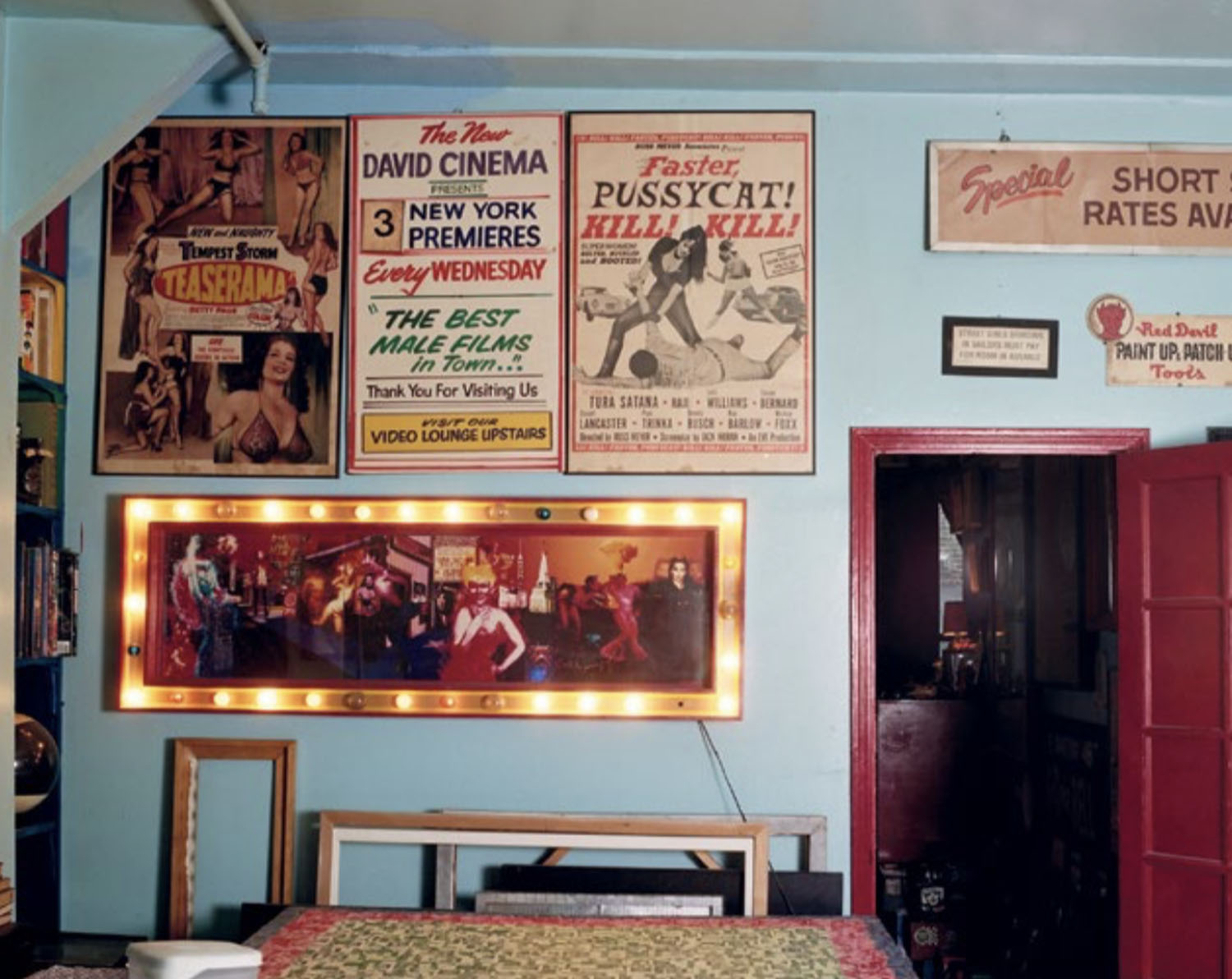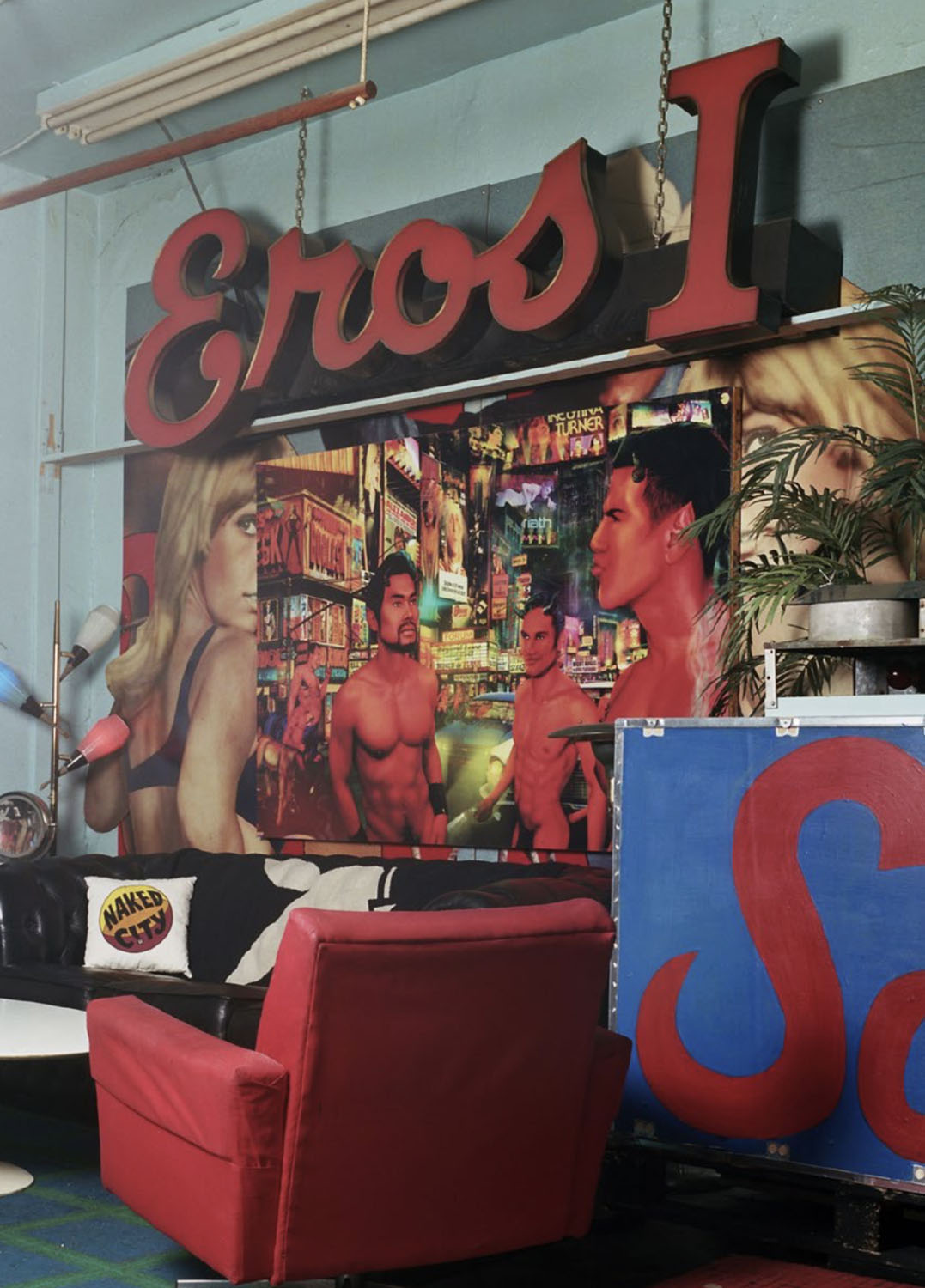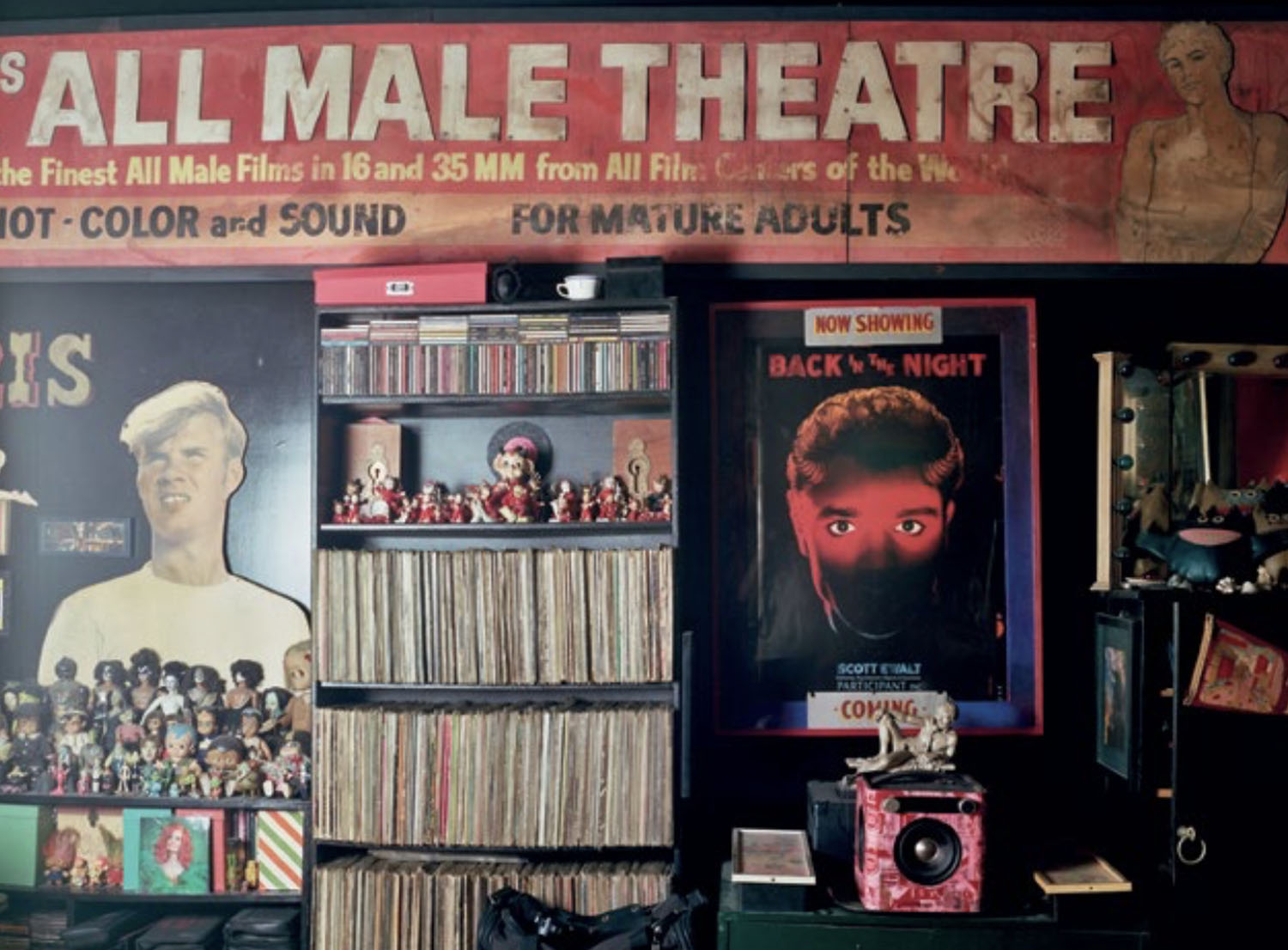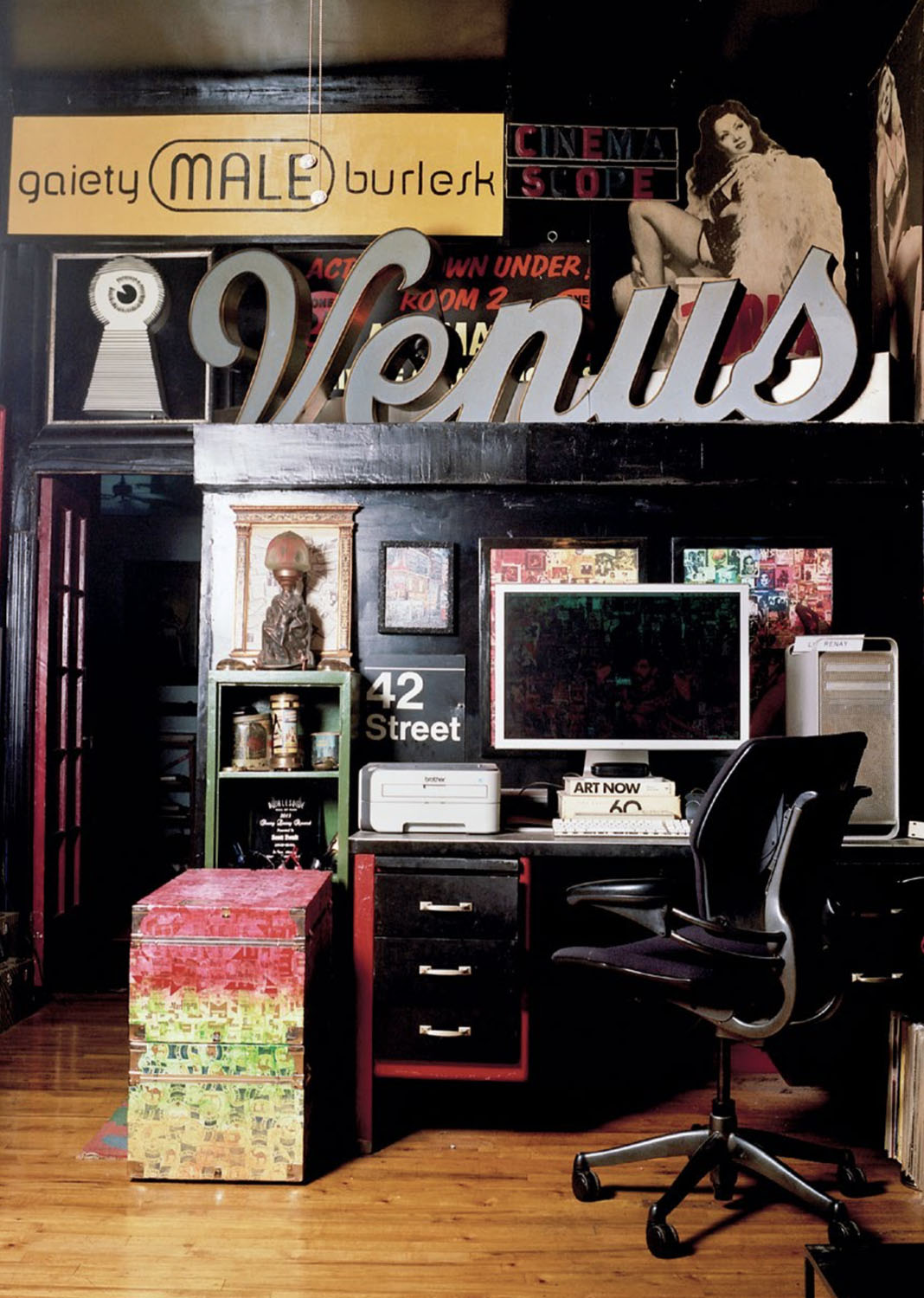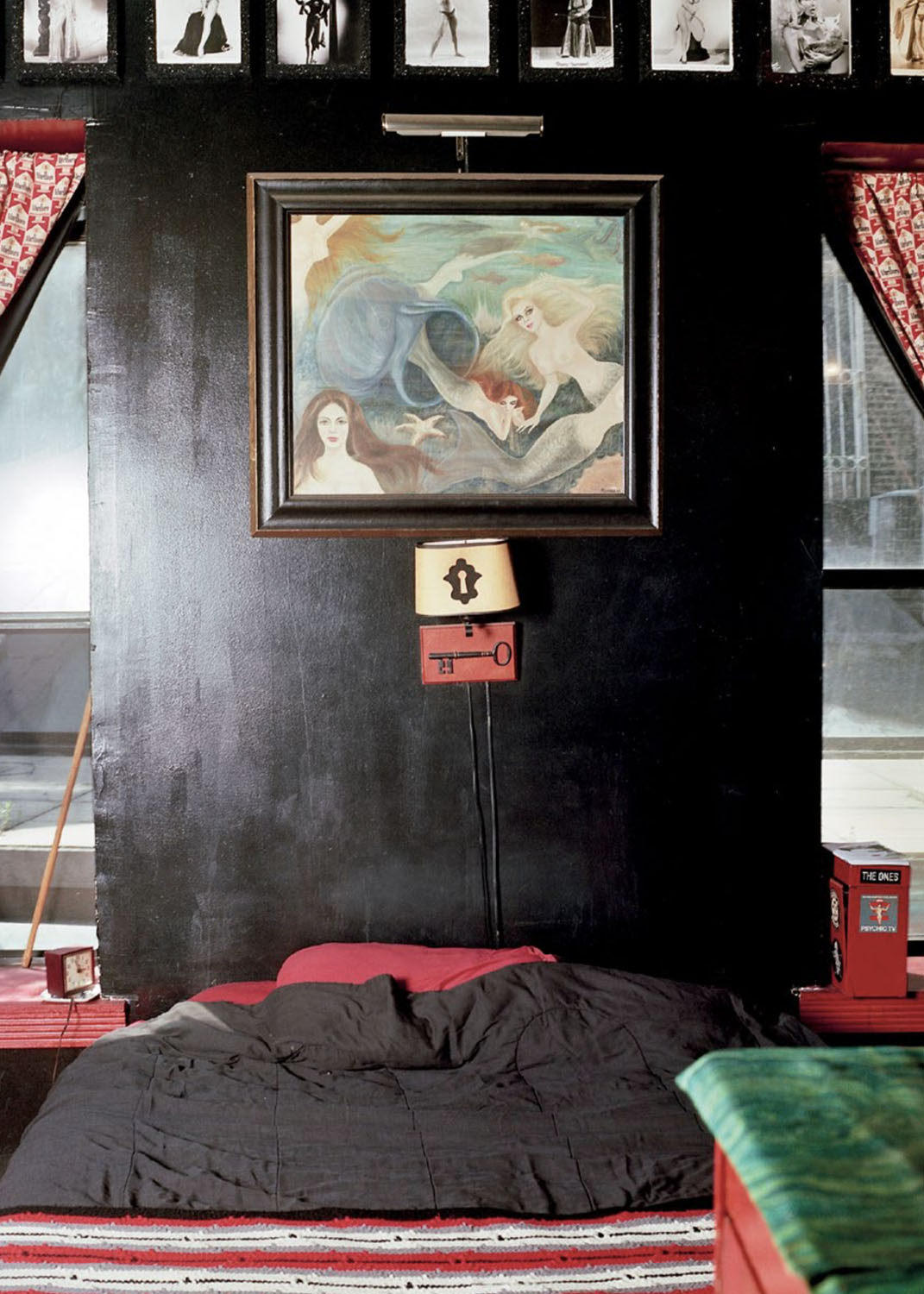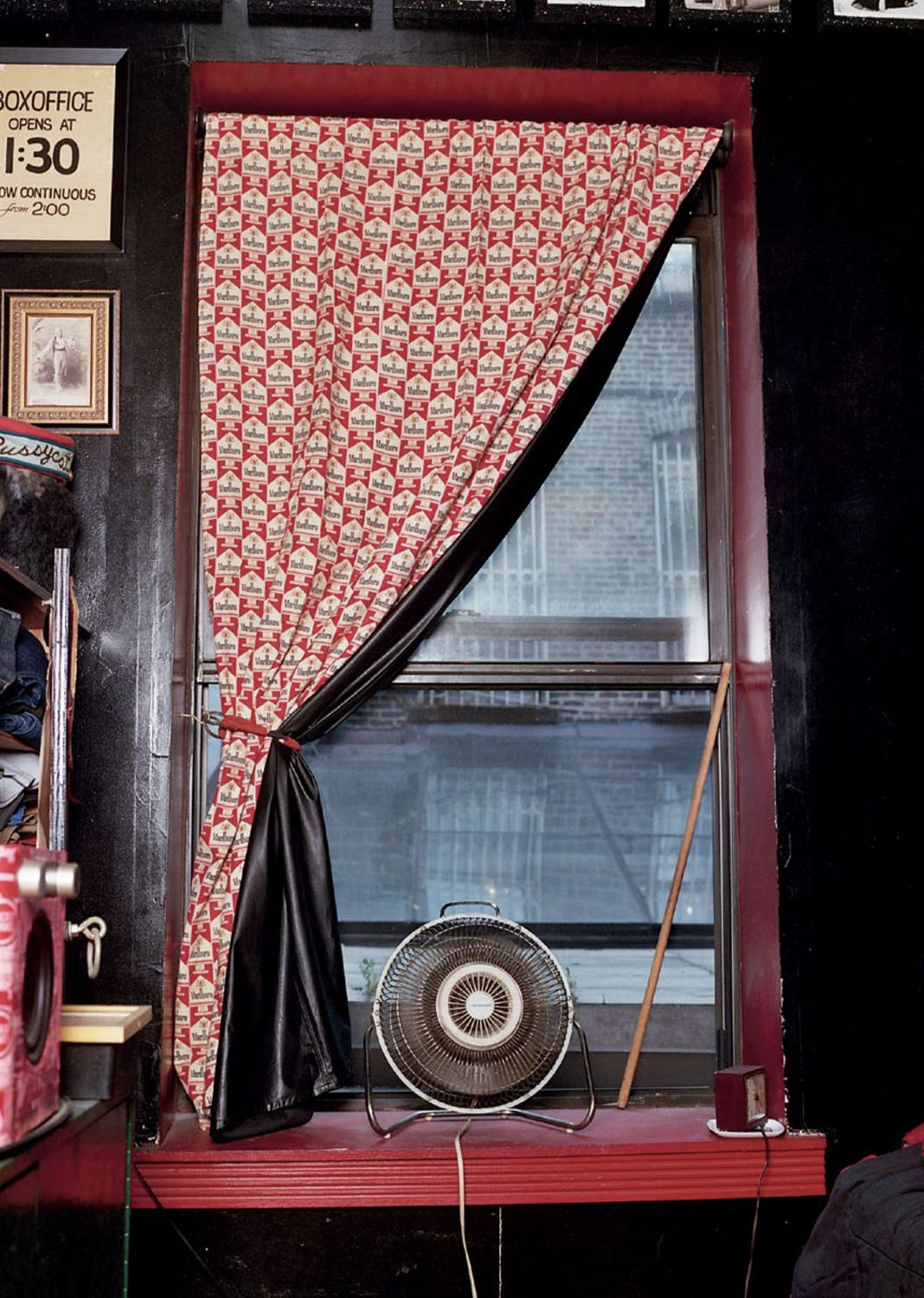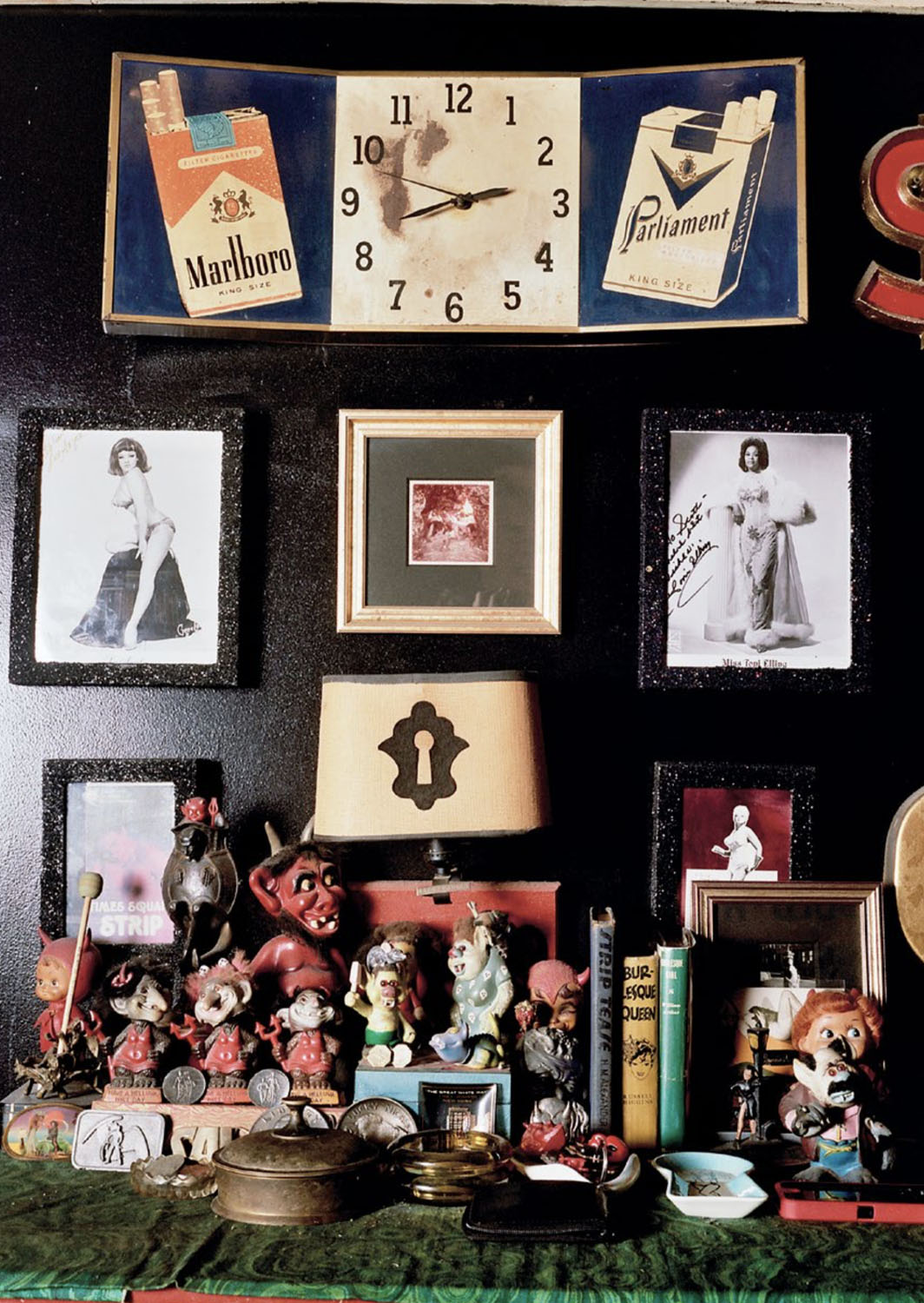SCOTT EWALT
Interview by Michael Bullock
Photography by Benjamin Fredrickson
Apartamento 12, 2014
Artist Scott Ewalt’s life-long passion for burlesque is unparalleled. It inspires his art, has guided his career, and has lead to many friendships, but it’s perhaps most apparent in the spectacular interior of his East Village apartment. In 2000, when Giuliani’s mission was to clean up Times Square, Scott’s mission was to save as much of it as he could possibly store. His one-of-a-kind collection celebrates the trailblazing performers and venues of New York City’s legendary burlesque scene. In his own work Scott continues this obsession, blurring the lines between collector, historian, and visual artist. His last show at Participant Inc., was a grand installation that mixed theatre signage, wallpaper, and memorabilia. The star pieces were his depictions of gangs of seductive devils roaming through intricately detailed cityscapes of Time Square at the height of it’s sleazy, chaotic glory; a decadent zone where all pleasure is encouraged. Talking with Scott is a brilliant web. His back-stories have back-stories. He’s obsessed with the origin of ideas. As he speaks, he connects lines through history in order to explain where concepts in fashion, art, music, and culture began. His militancy about this has made him a leading expert in downtown subculture, some of which he’s lived first hand, playing a leading role in what are some of the city’s best moments. Scott’s fairy tale introduction to New York began with being discovered by Thierry Mugler while still an architecture student at Princeton. He became Mugler’s muse for his iconic Vampire collection, starting a collaborative friendship, and long, wild ride through the height of the acclaimed designer’s dominance in fashion.
Let’s start with Betty Boop. Was she your first introduction to burlesque?
Probably. I was a big fan of Max Fleischer cartoons. He created her, Felix the Cat, and Popeye. I had a special interest in him because my great aunt was his nurse.
Why were you so fascinated?
I read that when Betty Boop danced, every tenth frame she would be nude. You can only see it if you stop and actually look at the individual frames. That made Max my hero. So the fact that I love strippers so much now makes perfect sense. Also, in the early cartoons, the backdrop for Popeye was always The Bowery, and I thought, “That looks great. I wanna live there.”
How did you end up getting this apartment?
The worst possible way. I was close friends with Luciana Martinez de la Rosa. I helped her move in here. She was only in the apartment for eight hours when she caught spontaneous meningitis and basically exploded. She had the boy in the bubble disease, but before they had even discovered it. Had they diagnosed it she would have had to live her whole life in germ free seclusion, but instead she had this insane career as a Carnaby St. DJ, glam rock muse (Roxy Music), punk rock muse (Vivienne Westwood), and then she was the queen of the Blitz. As much as I miss her, out of everyone I’ve ever known she crammed the most in to the fewest years.
Yikes, how strange.
Luciana was a painter. I know she would have been happy that a friend and fellow artist took the space. Yeah, so that’s the story.
What was it like when you moved in?
It really was the encyclopedia of CBGB’s. You’d go to the deli and you’d see Suicide or two of the Ramones, and on the other corner, Gerard Malanga, Lenny Kaye lived next door so Patti Smith was always around. And all the old beatniks like John Giorno, Robert Frank, who I’d see hanging out with that Broadway legend Uta Hagen. Almost anyone that wasn’t a bum was someone quite celebrated. I was in hog heaven and then all of a sudden it felt almost like someone unplugged a drain and all my heroes slipped through it. Everyone that made it special for me got pushed out.
But you stayed?
Well, in 2000 the building went up for sale for a ridiculously low price. Today I would get something the size of this bed for the amount of money I paid. So the other tenants and I pulled together to buy the place. We knew it was a once in a lifetime opportunity, plus I’d already collected all this burlesque signage and there was no way I’d be able to put this puzzle back together anywhere else. So, I decided to bite the bullet. I did everything I could, sold things, ran credit cards to the limit, and borrowed. Even Thierry Mugler lent me money to close. I barely made it.
Once it was yours did you renovate?
We had to. That’s when we found all the goodies. When we opened the walls they were stuffed with human hair because the top floor used to be a wig factory and when they would sweep the left over hair from the wigs, and it would get trapped in the walls. Eventually it filled up the entire negative space of the whole building. It insulated great but at the same time it was kind of horrifying.
And isn’t this place also rumored to be the notorious Suicide bar?
There was some debate about whether it was across the street or here. But when we excavated we found bottles of benzene which they used to make the cocktail so...
Can you explain the bar?
In the 1870’s they served the Suicide cocktail, which was benzene, cocaine and rum, and it was served to prostitutes. One would make you high, and two would kill you. A lot of women would drink two and then jump out the windows...
Dark... Let’s talk burlesque. At what point did you start collecting stuff?
The first time I visited New York I stayed in Times Square and I was completely blown away. It was at its Kochera peak of sleazy broken-down-ness. Everything was a hostess house, there was still taxi-dancing, and porno theatres that people lived in. I even saw a topless shoeshine booth. It was the Wild Wild West but in the middle of the city.
And it was all based around Burlesque?
Yeah, the girls didn’t have pimps. The majority of them weren’t even sex workers. I became fascinated with them. They didn’t sing or have a band but they were like, “I’m starring in a show and that show is just ME!” That takes such confidence. I have a lot of admiration for those performers because I wouldn’t be able to do it if my life depended on it.
Do you remember buying your first piece of memorabilia?
Around 1987 I became friends with Paula Klaw. She’s known for beating Betty Page with a hairbrush in all those famous pictures. She and her brother ran the notorious Movie Star News. They made those iconic Klaw movies with Page, Tempest Storm and Blaze Starr. I started buying photographs from them. Paula saw I was hooked and said, “You know I have an actual Tease-o- Rama poster from 1955. Do you want that?” I told her I would kill to have it. She sold it to me for six dollars. Today it’s worth something stupid like $6000. That was my first piece of burlesque memorabilia and I still have it in the other room.
How did you jump from that to signage?
Giuliani started ‘cleaning up’ Time Square and with the space I have in this apartment I finally had the room to store stuff, so I made friends with all the Greek women that ran all these theatres. I told them, “I’m on your side, Giuliani sucks and I think your business is fantastic, so if you are ever in a position where you want all of this excellent stuff to go to a great home where it will always be preserved and eventually end up in a museum, then call me and I’ll pay you good money for it.” One by one they all called and that’s how I got everything. I also would go down to the south side of 42nd street and go to all the construction and...
Pull stuff out of the trash?
No. I would ask for whoever was supervising the demolition. And it was, you know, a construction guy that would always ask, “Why do you want this crap?” And I’d say, “You’re just throwing it out, but I’ll offer you 50 bucks for it.” The next thing you know I had a team of construction scouts that would call me whenever they thought I might like something.
I heard your collection has the oldest male strip club sign in New York.
I think it’s the oldest in America period. (He points to the sign to right of his bed) That is the first outdoor sign that advertised showing all male films. They used to show Vapors by Andy Milligan at the Eros Theatre. That movie kept people coming to the theatre for 15 years because a guy takes his towel off and goes off screen and you could see his blury cock for like three tenths of a second.
So, obviously when you put this house together it was about showcasing your collection.
It was my therapeutic way of dealing with Giuliani. I thought if he is going to remove this amazing world from our city then I’m gonna make my own Time Square and sleep in the middle of it. Plus, I think it’s sexy. As I get older it may get creepy, but right now I still find it very sexy.
I love that you collect both the male and female history of burlesque.
It’s post-gay. My gender politics have always been that I like everyone.
Gender equality for strippers?
Exactly. I have definitely seen just as much of both. I like the exaggeration no matter what sex it is. They never look the same in real life as they do under a pink and blue light with music and costume. It’s a living illusion.
Were you recently inducted into the Las Vegas Burlesque Hall of Fame?
No, I was honoured with what they call a ‘Sassy Lassy’ award for outstanding contribution to the world of burlesque, and for my work helping the ladies figure out what the original soundtracks to their acts were. Some of them only had a memory of what they used to dance to. A lot of them hadn’t performed in over 30 years. It was a perfect symbiotic relationship, I got an inside track on the true history and they would get their act back together and a new friend.
How did they feel about the Museum?
Some of them, especially the ones that got married and found God, had guilt about their life in burlesque. The nicest thing about the Burlesque Hall of Fame is that it alleviated their shame and made them realise they were important sexual revolutionaries.
Out of all the ladies you worked with who was your favourite?
My favourite strippers of all time: Are Zorita, Kitten Natividad, Lilly Christine, Marinka, Liz Renay and Tempest Storm. Thanks to John Waters, Liz Renay and I struck up a friendship long before I started working with the museum. We were close for about 15 years until she past away in 2007. She was like Debbie Harry and Mae West all at once, and super sexual. Up until she died she scheduled three dates everyday. She told me once that she was truly blessed because she never walked into a room where she wasn’t the most beautiful woman. I’m sure it was true. I met Tempest Storm through the Hall of Fame. That was a big moment for me. She did not disappoint.
How old was she when you met?
80. She still looked absolutely unbelievable. She’s a real spitfire too. The ones with the names like Tempest and Satana have intensely strong personalities, and the ones with the softer names like Kitten really are the sweeter ones. They’re like comic bookcharacters. They completely live up to their character’s names.
Do they also honour male performers?
Not yet. Male burlesque has been going on just as long as female burlesque, but being a male stripper is even less socially understood. Not only are you a sex worker but you’re a sex worker based on a female profession. There’s double guilt so the history has been pushed underground. Many of the famous male performers still won’t talk about it.
Is that something you try to correct in your own artwork?
I have been working on the same series of images forever. I started off wanting to document what Time Square looked like. I didn’t want them to look like Edward Hopper's or nostalgic ‘70s photo-realistic paintings, because the whole thing about Times Square that made it magical for me was the confusion and chaos and the constant overlapping of pop culture. I needed something to inhabit these cityscapes and I decided the only logical occupant would be devil versions of the male strippers that I hire to work my night at The Cock.
Obviously. So you combined all your loves?
Yeah, that’s what I think art is about. It’s like a potion. You put in all the ingredients that you love in order to get what you want. I shopped the show around for years and got practically laughed out of town. Then, thanks to encouragement from Charles Atlas and Kembra Phafler, Lia Gangitano from Participant offered me the show last spring. It was super fun. I got to do everything I wanted to do.
The press release mentioned ‘psychotronia’. What’s that?
It’s the more exaggerated version of pop culture. If Marilyn Monroe and Elizabeth Taylor were the norm, then Jayne Mansfield and Liz Renay were psychotronia. It’s this whole attitude of life where everything is completely turned to 11. The violence is ridiculously violent and the sex is ridiculously ridiculous, and all the people that made the movies were incredible hustlers. The most successful psychotronic filmmakers were Russ Meyer and Roger Corman. For me psychotronic movies were actually closer to reality than what Hollywood was doing, trying to imitate reality. I’ve always loved this definition of camp: the lie that tells the truth. That is what psychotronia is.
I never heard that definition. I love it... OK, one last topic. Is it true that you were one of Thierry Mugler’s muses?
Hmm... Well. He heard about me from a mutual friend. When he approached me he said, “You’re the person I’ve been looking for this vampire collection I’m about to do. I heard you study architecture and you’re clearly a vampire.” He liked the way I cut my hair at the time because it was cut to a point and completely flat, when everybody else had their hair moussed as high as they could get it. My group of friends were all going against that. We had flat hair-dos and were working outfits with unadorned silhouettes, basically black body stockings. He became fascinated with all of us. I was still in school at Princeton and he started sending me sketches of ideas for the Vampire collection and invited me to come to Paris and model in the show with Jerry Hall.
Wow. A New York City fairy tale!
At the time I was a wallflower. I never considered myself good looking at all. He was the first person to say, “I love the way you look and that you go to this prestigious school and you’re a swimmer.” All the things I thought were social spurs he thought were super great. When we finally hung out I knew all of his references and he knew everything about everything. I fell completely under his spell. If he wanted to see a certain colour of red, he would take a Concorde to China and go see a parade. In that period he was really, really strong and his fragrance made him incredibly wealthy. From ’88 to ’98, he had his finger on the pulse more than anyone else in fashion.
Why was he coming to New York so much?
He was bored with the aesthetic repetition of Paris. At that point his entire social life was seated dinners with half men and half women and everyone dressed in Mugler, telling him, “Yes, you’re the greatest.” He needed to shake things up and find new inspiration, and he found us. We were all wild kids that lived ‘pedal to the metal’. It was really exciting because he took all of our suggestions seriously and could really make anything happen. He would ask, “Who’s really making a wave in pop-culture right now?” And I’d tell him, “Everyone is in love with Traci Lords and Crybaby and the next thing you know, Traci Lords was on the runway. I was about 22 and he was 40. It was funny, we used to take a limousine that was a block long to Boy Bar. For a while, his New York family actually equaled his Paris court.
Did he dress in his own clothes?
He actually was the caricature of the Mugler man. I always felt that I could be brutally honest with him because I had nothing to lose. He once showed me a couple of the tapes from his shows so I told him, “The only thing that’s not incredibly excellent is the music.” At that time, fashion show soundtracks were either disco or classical. Those were our two options. Maybe, jazz if you were really feeling wild... So he said, “OK, you want to take the challenge. Here are the different themes for my next show.” So in ‘91 he invited me to Paris and we did a burlesque themed show starring Diana Ross, and everyone thought that it was the most revolting thing that they had ever seen in their entire life.
Were you fired?
No, it became the beginning of a new era for him. His Vampire and Atlantis collections had both done amazingly well. And by the third time we collaborated he was comfortable with my perspective and let me include all these odd bits of music. Some of my choices then, I would never dare do today. Like when in 1991 when I played Welcome to the Jungle by Guns N’ Roses as the woman that was about to become the First Lady of France walked the runway. At another show I used all this super racist, Chi- nese music from the ‘50s because the theme was ‘Hong Kong Honky Tonk’.
Are you still friends? You said he loaned you money.
He’s always been super, super generous with me and he’s just always been the most amazing guy, but unfortunately, when he became Manfred Mugler, he started to pull away from most of us.
That’s too bad.
So now you know nothing about the apartment and everything about me.
Perfect. As a nightlife veteran do you have any parting wisdom for the new kids?
My advice for living in New York is to keep your overhead low. Also, this city is an endurance test. If you don’t pace yourself you’ll burn out. That elasticity that you have when you’re in your 20s really ends. After that you have to have six drinks instead of 20, and if you’re gonna do drugs, do them once a month. You have to realise your health and your time are extremely important.
